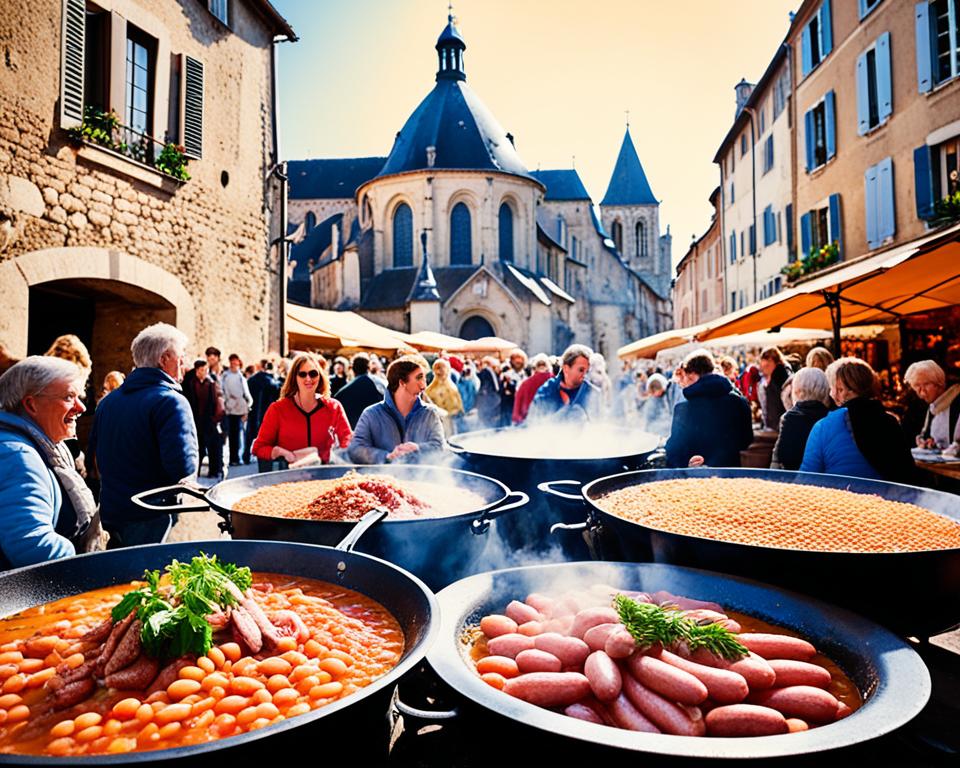French cassoulet is a rich and hearty casserole dish from southern France. It combines tender duck confit, savory pork sausages, and creamy white beans. This blend is simmered to perfection, offering deep, complex flavors and a satisfying texture.
It’s a classic in French cuisine and perfect for winter. This dish provides comfort and fills the soul.
Read interesting things at : apportfolioasia
Key Takeaways
- French cassoulet is a rich and hearty casserole dish from southern France.
- It blends duck confit, pork sausages, and white beans for deep, complex flavors.
- This dish is famous for its satisfying texture.
- It’s a perfect winter meal, offering comfort and filling the stomach.
- The slow-cooked method is key to its signature taste and feel.
What is a French Cassoulet?
A French cassoulet is a slow-cooked casserole. It includes white beans, duck confit, pork sausages, and more meats. All of these ingredients simmer together to create a rich flavor. This dish comes from the Languedoc region in southern France. It has been a favorite there for centuries.
Origins and History
The French cassoulet comes from the Languedoc region. Locals have cherished it for many generations. It features white beans, duck confit, and pork sausages. These elements show the region’s rich agricultural offerings and the cleverness of its cooks.
Regional Variations
The dish has traveled across France, inspiring unique versions. Each region uses its own ingredients and cooking styles. For instance, Castelnaudary’s version includes fava beans. Meanwhile, in Carcassonne, you might find lamb or mutton.
Traditional Cassoulet Ingredients
At the heart of a traditional French cassoulet are the white beans. They are slowly cooked with the other ingredients. This creates a creamy, stew-like texture. The cassoulet also includes duck confit and pork sausages. These add a rich flavor and a slightly spicy touch. So, the white beans, duck confit, and pork sausages are key to a classic cassoulet.
Beans: The Foundation
White beans are the base of a traditional cassoulet. They are slowly cooked with other ingredients. This makes the cassoulet creamy and stew-like, giving it a special texture.
Meat: Duck Confit and Pork Sausages
The meat in a cassoulet is crucial for its taste. Duck confit adds a rich flavor with its tender meat. Equally important are the pork sausages. They add a savory and slightly spicy taste. Together with the beans, they make the cassoulet a hearty and delicious meal.
The Art of Slow Cooking
The secret to a great French cassoulet is slow cooking. You start by simmering beans with herbs and veggies. Then you layer the meat and more ingredients in a deep dish. This helps the flavors mix well and gives the dish a tasty crust.
Preparing the Cassoulet
Start by simmering white beans with veggies and herbs. This creates a creamy base for your dish.
Baking and Layering
After the beans are ready, it’s time to bake and layer. You put duck confit, pork sausages, and more in layers. This makes the taste and the crust just right.
The dish then bakes slowly for hours, maybe even a whole day, at a low heat. This makes the flavors better and the textures creamy. Cooking this way turns simple ingredients into something truly special.
French Cassoulet: A Languedoc Region Specialty
French cassoulet is a dish that spreads across France. Yet, it shines most in the Languedoc region of the south. This area is rich in agriculture and proud culinary traditions, making it the perfect place for cassoulet. Here, the dish has deep roots and has evolved uniquely in every local community over centuries.
The Languedoc region boasts many types of cassoulet, from Castelnaudary to Carcassonne. This diversity marks it as the true home of the French dish. Local chefs and families continue to refine and cherish their own versions.
Serving and Pairing Cassoulet
Cassoulet is a famous French dish. It is served in a deep, oven-safe dish or casserole. This showcases the layers of beans, meat, and the golden crust. The dish looks amazing and sets the tone for a great meal.
Wine Recommendations
Cassoulet pairs well with bold red wines from the Languedoc region. Minervois, Corbières, and Fitou wines are great choices. They match the dish’s strong flavors and make the meal enjoyable.
Accompaniments and Sides
Fresh French bread is a must-have with cassoulet. It helps soak up the tasty juices. Simple green salads or roasted potatoes add a light touch. They balance the rich flavors of the cassoulet, making a complete meal.
Cassoulet: A Hearty Winter Dish
French cassoulet is a must-have in the winter. It’s more than just a meal, it’s like a warm hug for your insides. This slow-cooked dish has a hearty texture and strong meaty tastes, making it ideal for cold weather.
It’s popular in France because it’s not only tasty but also keeps you full. You can share it with family or serve it at a special event. Cassoulet truly represents the heart and soul of French comfort food.
Mastering the Crust
The French cassoulet is known for its crunchy bread crumb topping. It adds a nice texture and color to the dish. Getting this part right is essential for the perfect cassoulet crust.
The Iconic Bread Crumb Topping
The bread crumbs come from old, French bread. They’re toasted and mixed with butter or duck fat. Cassoulet gets this mix sprinkled on top before baking. In the oven, it turns into a crisp, tasty crust over the cassoulet’s soft beans and meat.
Vegetarian and Vegan Cassoulet Variations
The traditional French cassoulet is well-known for its meaty ingredients. But, over the years, vegetarian and vegan versions have become popular. These options swap out meat like duck and pork for mushrooms, root veggies, or meat alternatives. White beans are still key, but the taste changes to fit a vegetarian or vegan diet. This twist lets more people enjoy the classic French flavors, regardless of their dietary needs.
To show how cassoulet recipes can vary, a table is used. It compares the ingredients and ways to make the traditional, vegetarian, and vegan cassoulets.
| Ingredient/Preparation | Traditional Cassoulet | Vegetarian Cassoulet | Vegan Cassoulet |
|---|---|---|---|
| Beans | Tarbais or Lingot beans | Tarbais or Lingot beans | Tarbais or Lingot beans |
| Meat | Duck confit, pork sausages | Mushrooms, root vegetables | Seitan, lentils |
| Cooking Method | Slow-cooked in the oven | Slow-cooked in the oven | Slow-cooked in the oven |
| Bread Crumb Topping | Traditional bread crumbs | Breadcrumbs or crushed crackers | Vegan breadcrumbs or crushed nuts |
These variations make cassoulet accessible to all, no matter their dietary choices. They offer the same rich and cozy experience, with ingredients that fit different needs.
Cassoulet’s Cultural Significance
French cassoulet is more than just a dish in the Languedoc region. It represents local heritage and traditions deeply. In places such as Castelnaudary and Carcassonne, cassoulet festivals happen every year. These events show how important the dish is to local people and their culture.
Traditions and Festivals
Local chefs, producers, and those who love cassoulet all come together at these festivals. They celebrate the dish with cooking shows, tasting events, and lots of fun. This meal is a symbol of local pride and unity. It brings people from different communities together, sharing the rich food culture of the Languedoc.

Tips for Perfecting Your Cassoulet
Getting the perfect French cassoulet just right takes time. You need to pay close attention to how it’s made. Here are some tips for making your cassoulet shine:
- Choose the best ingredients: Go for top-notch white beans like Tarbais or Lingot. Use only the highest quality duck confit and pork sausages.
- Soak and cook the beans the right way: Getting the beans to the perfect texture is key for success.
- Layer your dish well: Place the beans, meats, and more in the cassoulet dish so they mix well when cooking slow.
- Cook on low heat for a long time: The cassoulet needs time to soak in all the flavors.
- Top with golden-brown bread crumbs: This makes your cassoulet look and taste amazing.
With these tips for perfecting cassoulet, you’ll make an incredible French cassoulet. It will truly represent this popular dish.
Cassoulet: A French Culinary Masterpiece
French cassoulet is a standout dish in French cuisine. It’s known for its slow cooking, mixing local ingredients and traditional methods. The dish celebrates the nation’s love for its food culture.
The dish represents true French home cooking. It’s a perfect fusion of flavors and textures. This makes the french cassoulet beloved worldwide.
Modernizing the Classic Cassoulet
The traditional French cassoulet is a well-loved dish. However, modern chefs and home cooks are now adding twists and adaptations to it. They aim to keep the dish’s history alive while bringing new flavors and skills to the table.
Contemporary Twists and Adaptations
Some chefs choose other meats over the classic duck confit. They use slow-cooked lamb or beef. Others play with regional ingredients or try different bean varieties. This makes each dish a special take on the local cuisine. Vegetarian and vegan versions show the cassoulet can bend to anyone’s eating style.
These modern adaptations cherish the French cassoulet’s long history. They also explore new cooking possibilities, making it all very exciting.

Storing and Reheating Cassoulet
It’s very important to know how to properly store cassoulet and reheat cassoulet. This keeps its delicious taste and texture. After cooking, you can keep cassoulet in the fridge for a week. You can also freeze it for several months.
When it’s time to warm it up again, go slow. Use the oven on a low heat or the stovetop. This lets the flavors come back without getting dry. Adding a little broth helps keep it moist. These methods keep the French classic tasting just right.
| Storage Method | Duration |
|---|---|
| Refrigerator | Up to 1 week |
| Freezer | Several months |
Heating cassoulet, do it gently to stay moist. Here’s how:
- Preheat your oven to a low temperature, like 300°F/150°C.
- Put the cassoulet in an oven-safe dish and cover it.
- Warm it for 30-45 minutes, until it’s hot.
- Or, heat it up on the stovetop on low, stirring now and then.
- A little broth can help make it moist again.
Remember, the right way to store and reheat is key. You want to keep this French favorite tasting great.
Conclusion
French cassoulet is a timeless favorite in French food history. It features a mix of soft white beans, tasty duck confit, and flavorful pork sausages. This dish is a window into the rich food traditions of Languedoc. It has evolved from simple beginnings to a culinary icon.
This dish is perfect for winter warmups or special occasions. It shows the heart of French food culture. Chefs worldwide take inspiration from this classic to create new versions.
The French cassoulet stands as a symbol of French culinary skill. It highlights slow cooking, using local ingredients, and paying homage to traditions. Every bite transports us to Languedoc in France. There, the true spirit of French food shines brightly.



